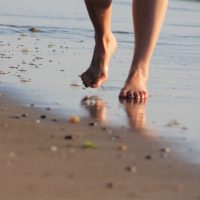Recently updated on March 26th, 2024 at 09:12 pm

Pounding the pavements is a great way to keep fit, sprint off the day’s frustrations, breathe in the fresh air, and take some ‘me’ time.
But are you taking care of your feet properly?
Each foot is made of a complex collection of bones, joints, soft tissue, and muscles. They let us stand upright and perform activities like jumping, walking, and running. The forefoot contains phalanges, which are more commonly known as toes, and the longer metatarsal bones.
The midfoot is a pyramid-shaped collection of bones that form your foot arches and include the navicular, cuboid, and cuneiform bones.
The hindfoot comprises the ankle and heel. The talus bone supports the fibula and tibia leg bones, and finally, there is the calcaneus, or heel bone, which is the largest in the foot.
Over 100 tendons, ligaments, and muscles run along the surface of your feet, allowing everything to connect and provide the complex movements you need for motion and balance.
The Achilles tendon attaches the all-important calf muscle to the heel so that you can run, jump and stand on your toes.
In just one foot, there are 26 bones and 33 joints.
If any of these crucial elements of your foot are misaligned, your feet may well hurt, and you’ll probably begin to notice alignment issues in other parts of your body.
What Causes Foot Pain?
There are various reasons why you can suffer from foot pain. When you run, your foot absorbs an incredible amount of force on a small surface. Runners can also suffer from stabbing pains in their heels, particularly after periods of rest.
This tends to be inflammation of the plantar aponeurosis located on each foot’s sole between the metatarsophalangeal and heel joints.
How to Treat Foot Pain
Buy New Shoes
There are so many trainers and running shoes on the market; it’s wise that you seek advice from the salesperson. They will advise you on the best type of shoe, measure your feet for the right size and suggest a style that offers the correct amount of support.
They will look at and analyze your gait correctly so that you can buy the shoes that are right for you at Lucky Feet Shoes anaheim hills. They’ll discuss all of the latest styles and models, new technology, and what will work best with your feet.
Remember that you need to replace your shoes after 350 to 500 miles of wear. Perhaps use your fitness tracker to record the miles that you run, walk the dog or run errands; every step means that you are creating wear and tear on your trainers.
Socks
You might be surprised that wearing the incorrect socks can cause you injury. Socks provide the much-needed cushion between your shoe and your skin. As long as they are correctly fitting, they will prevent any friction that can lead to irritation and injury.
Podiatrist
Pronation is the natural movement of your feet, and if compromised, your gait can show signs of stress, which can cause overpronation or supination. Pay a visit to your podiatrist if you have any concerns. They might prescribe orthotic support, motion-control, or cushioned shoes to help address the problems.
Massage
Foot massage has been around for hundreds of years. You can combine most forms of foot massage with the healing elements of shiatsu and reflexology. There are more than 7,000 nerves in each foot, and applying pressure can release energetic blockages. Massage can also be used as a form of pain relief, helping speed up recovery from an injury and reduce stress.
Foot Massage Devices
Targeted stimulation to your feet can ease tension in your body, particularly your legs and lower back. You punish your feet when you run so that they get sore and tired.
A good foot massager for runners will help to relieve chronic foot discomfort from plantar fasciitis by providing a relaxing, deep-kneading, and squeezing massage. A massage increases the release of hormones into your body that create a sense of wellbeing and relaxation.
Rest
If you feel pain, then take a break from running so that any inflammation reduces. You could perhaps choose more supportive forms of exercise such as swimming, cycling, aqua jogging, or even skating.
Strengthen the Rest of Your Body
It’s very important to make sure that the rest of your body’s muscles are strong so that you have a good weight-bearing pattern when you run. Also, ensure that you practice regular stretching.
If you experience acute pain, then consult with your doctor or have your sports physician examine your feet and discuss a comprehensive treatment plan.
Conclusion
Your overall wellbeing and strength are essential to prevent injuries. Ensure that you have the correct socks and running shoes that support your feet, and remember to rest if you feel any pain. Always try to make time and regularly pamper your tired and sore feet with a foot massager.
Author Bio
George Drennan is a freelance writer and health enthusiast. When he’s not jogging through the Shropshire countryside or trying to break his personal best 2K rowing time, he can be found contributing tips and advice online to help other people meet their health and fitness goals.



